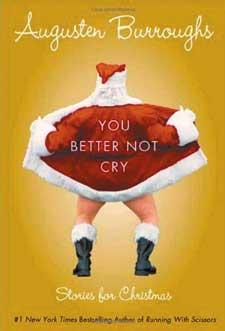Waking up next to an ill-advised one-night stand is bad enough. But waking up with an aging Frenchman in a Santa Claus costume is in a different league altogether. Such was the fate of Augusten Burroughs, the best-selling author of Running with Scissors. It’s the basis for one of the holiday-themed tales in his new volume of short stories, You Better Not Cry.
“This was a new low for even me, a person who was essentially the gold medallist in the category,” writes Burroughs. “Was it possible my glasses were so filthy I could have mistaken him for a hockey coach?” Anyone who’s ever donned a pair of beer goggles can probably relate.
Like much of Burroughs’ work, the stories are infused with his signature dry wit. In fact, the 44-year-old writer has become an expert in mining his own unconventional upbringing for both comedy and pathos.
In Running with Scissors, he tells the story of how his alcoholic mother deposited him at her psychiatrist’s home, never to return. There he was abused before leaving at 17 to eventually become a wildly successful advertising copywriter. Published in 2002, the book was on the New York Times bestseller list for four consecutive years and was made into a darkly funny movie starring Annette Bening and Alec Baldwin.
You Better Not Cry contains the same mixture of dark and light.
It begins with childhood memories of Christmas and stretches to the present day. Unsurprisingly, this is not a cutesy “why I love the holidays” kind of book. In Burroughs’ world, the season is synonymous with misunderstandings (Jesus and Santa are the same person, right?), disappointment (a gingerbread creation that’s more tenement than house) and disaster (a ground-floor flood just before Christmas).
But it’s not all doom and gloom. Burroughs’ special skill is that he can find the funny side of almost any situation.
When his mother and father are screaming at each other on Christmas morning, the teenage Augusten dances around the room munching candy canes and dropping wrapping paper on his parents’ heads. And his close encounter with a life-sized wax figurine is bizarre to the point of creepy, but you just can’t help grinning at the visual image of boy-meets-Santa.
The adult Augusten is more circumspect about the joys of the holidays. He’s wistful for a type of Christmas he’s never had — with a perfectly decorated tree and assorted seasonal delights — but his expectations are pretty low. “I have loved Christmas my entire life, and yet? Every single one has really been kind of hideous,” he tells his partner, Dennis. “It’s like I have a genuine Christmas curse or something. All I want is just one good, normal, happy holiday. A little one.” And by the end of the book, it seems like he might just get his wish. Well, almost.
The most moving aspect of You Better Not Cry is the stark contrast between the unstable family life of Burroughs’ childhood and the new family he creates with Dennis and their two French bulldogs. The couple lives in a house they designed and built together in rural Massachusetts, just a couple of doors away from Burroughs’ older brother. For Burroughs, it’s almost too good to be true. “Though many things could be said about my life over the years, ridiculously perfect would never have been among them,” he writes.
And, of course, it’s not perfect. The couple were recently rumoured to have separated. But Burroughs’ gradual recognition of what it means to be loved — and what a loving household could actually look like — is an emotional journey that speaks directly to the queer community. Because whether we spend the holidays with our self-made families or our biological ones, the point is that we have a choice. And thank Santa for that.

 Why you can trust Xtra
Why you can trust Xtra


